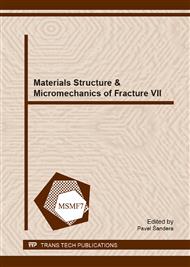p.225
p.229
p.233
p.239
p.246
p.250
p.254
p.258
p.262
Modeling of Fatigue Crack Initiation in Wire-Bonds Using a Novel Approach of Strain Gradient Theory
Abstract:
The fatigue life of wire-bonds was measured with use of a 20 kHz ultrasonic testing system. Thereafter, the experiments were interpreted by Finite Element Analysis. First, simulations were performed according to classical continuum mechanics. They predicted stress concentrations at the location where crack initiation was found experimentally. However, the stress concentrations showed the characteristics of stress singularities even for loading cases corresponding to the regime of very high cycle fatigue, i.e. fairly moderate loads. In subsequent simulations, the singularities of stress concentrations could be removed on the basis of a newly developed version of strain gradient elasticity, resulting in predictions that agreed well with experimental results.
Info:
Periodical:
Pages:
246-249
Citation:
Online since:
November 2013
Authors:
Price:
Сopyright:
© 2014 Trans Tech Publications Ltd. All Rights Reserved
Share:
Citation:


